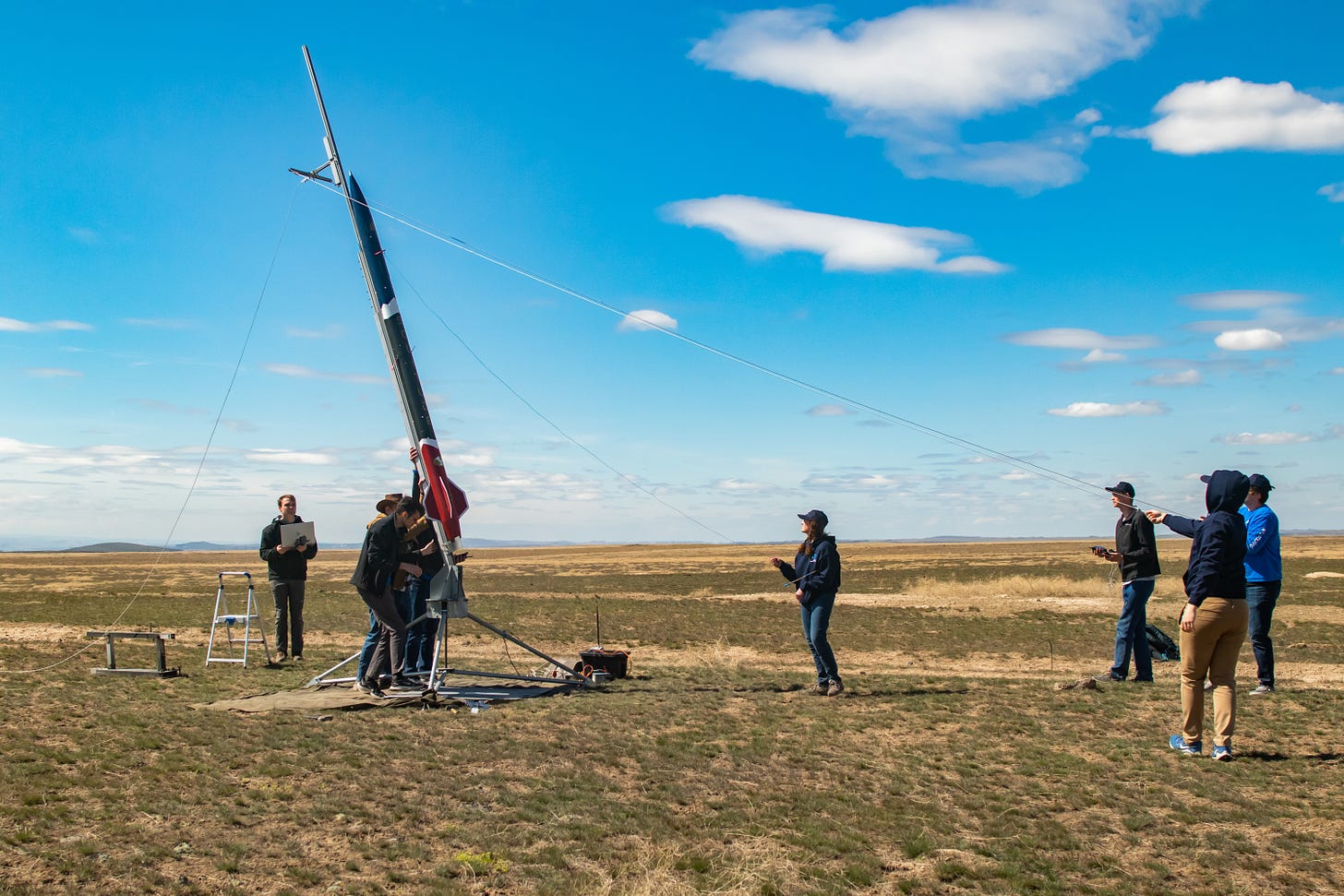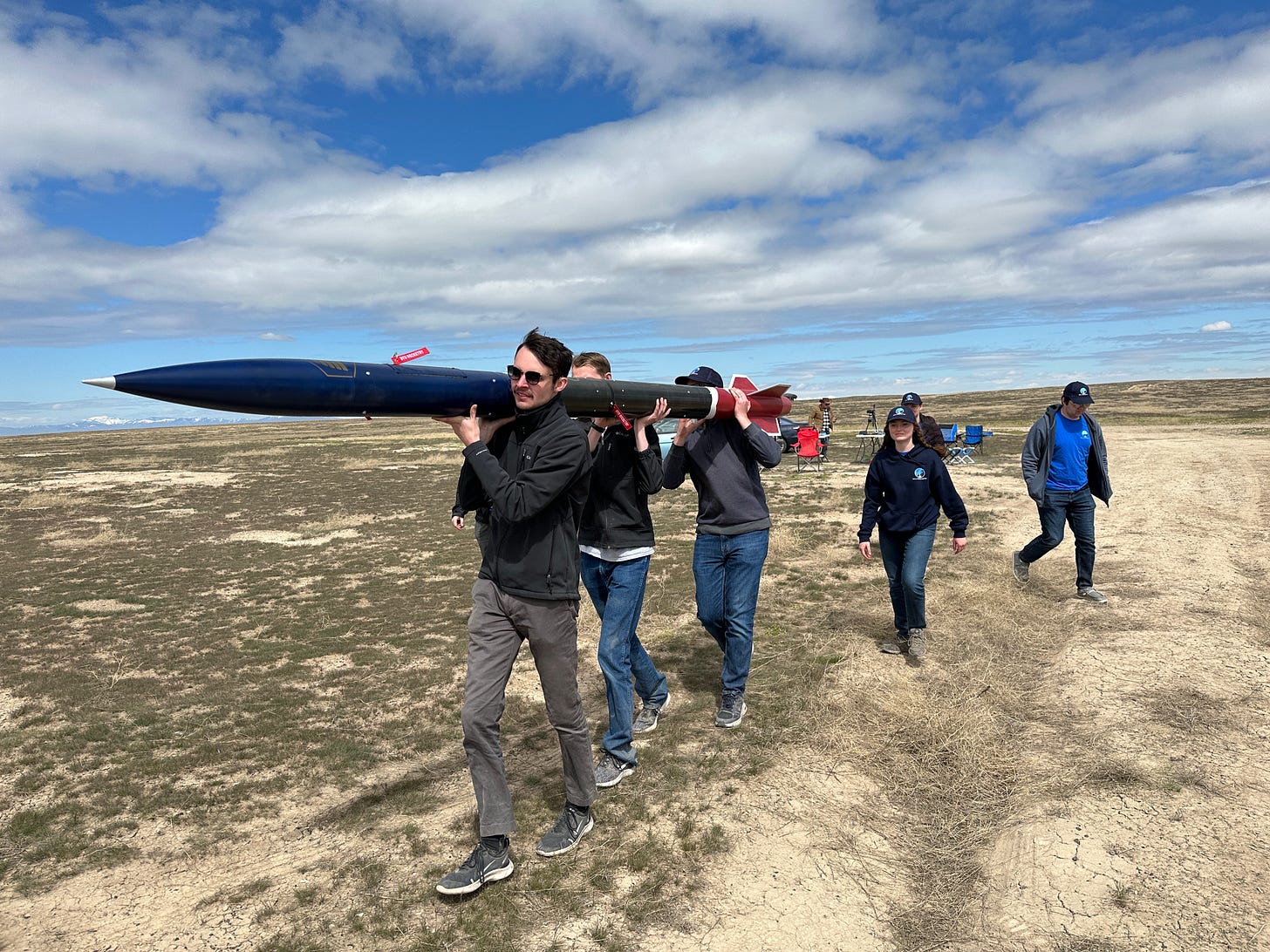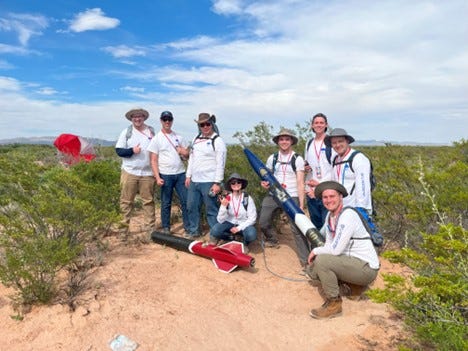Rocketing to New Heights
How BYU's High Power Rocketry team won the overall prize at the 2023 Spaceport America Cup, and what rocketry teams can do for YOU

Rockets thundering into the sky is a sight that defines the aspirations of an entire industry. With numerous companies cropping up to provide access to space, the demand for the next generation of aerospace engineers is growing. This new generation, full of excited students like you, is hungry for opportunities to build their skills and leave their mark on space, and this is exactly what rocketry clubs and competitions help prepare you for.
A good example is the annual Spaceport America Cup, the largest intercollegiate rocket competition in the world, hosted in New Mexico by the Experimental Sounding Rocket Association. With various categories calling for different altitude targets and motor types and numerous awards bestowed, the Spaceport America Cup has many distinct outlets for students to aspire to. Roughly 1700 students and faculty from approximately 150 academic institutions from across the globe answer the call to compete and prove their engineering prowess.
We are former members of one such student team: the Brigham Young University High Power Team. We hope that in sharing our journey with you, we will inspire you to seek your own opportunities to chase your career goals.
BYU Rocketry
First, we’ll explain a little about our club as a whole. Our High Power Team is a subset of a larger group called the BYU Rocketry Association. Our organization boasts a student body consisting of over 100 students. The mission of the BYU Rocketry Association is not just to build rockets, but to build engineers. As a completely student-led organization, we accomplish this by providing hands-on experience and meaningful projects that enable students to become innovators in the space industry. It’s with this goal in mind that our association organizes a High Power Team each year to represent the club.
BYU Rocketry has had a team competing in the Spaceport America Cup since 2008 when the competition was called the Intercollegiate Rocket Engineering Competition. Almost every year since then we’ve selected a team of 9 to 14 upper-class students to design, build, test, and fly a high-power rocket to compete. This project allows students to gain the type of resume-building aerospace engineering experience that employers such as NASA and SpaceX are looking for. While this gained experience is the main reason we choose to compete, in recent years our High Power Teams have also achieved more tangible success, earning numerous awards. Perhaps one of the most impressive showings was by our 2023 High Power Team, who not only won a technical achievement award and took first place in their category (10k COTS), but also won the entire competition as the judge-selected overall best team.
Design Process
Before our team could go off and win awards, they had to start where all great products and ideas do: the beginning of the design process. Once our team is selected, they set to work brainstorming ideas and fleshing out the best ones. This process of developing the initial rocket and payload designs culminates in design reviews where our team presents to a panel including Association leadership, University professors, local rocketry experts, industry professionals, and Association alumni. Once initial designs are selected, we hold a Preliminary Design Review. From this initial set of feedback, we develop tests and procedures to help validate and inform the design, leading to the Critical Design Review. This design review is the final go/no-go for our team before beginning rocket manufacture.
Rocket Construction
With the successful completion of our design reviews, our team is ready to begin rocket construction towards the end of the fall semester. Our High Power Team is split into three subteams which work on separate components of the rocket. The GNC subteam works on constructing the avionics bay and setting up the flight computers that will monitor the rocket’s altitude and command the deployment of parachutes. The Payload subteam works on building and testing the scientific experiment that will fly in the rocket. Our 2023 team selected the ambitious project of designing a system to eject the payload from the rocket mid-flight, which is not commonly done at the competition. Designed to study the night sky cooling effect, the payload was designed to eject from the rocket after apogee, come down under its own parachute, and collect temperature data from various coated panels on its side. Meanwhile, the Structures subteam gets busy constructing the airframe of the rocket itself. Our 2023 team decided to have the fiberglass nosecone be the only commercially purchased component of the rocket’s airframe, with the body tubes, couplers, and fins made in-house out of carbon fiber.
Other important team roles include the team lead, who is responsible for administrative tasks, and the systems engineer, who works with all three subteams to coordinate component integration and keep a current model of the rocket. With help from the team lead and structures subteam, our systems engineer also worked on several simulation projects, including a small wind tunnel model to verify the rocket’s simulated center of pressure and using laser vibrometry to characterize the fin flutter frequency (frequency at which the fin would vibrate enough to cause damage) of the team’s carbon fiber rocket fins. As all of these components came together, our rocket took shape and was given a name: Solitude, following the BYU Rocketry tradition of naming competition rockets after mountains in the Wasatch Range.
Test Flight
We took Solitude to a launch site in Idaho for a maiden test flight at the end of April 2023. We were elated at the flight’s success, with the motor firing, parachutes deploying, and payload ejecting successfully. Upon recovering the rocket post-landing, we found that the body tube housing the payload was split in half, requiring more redesign and rebuilding to get the payload ejection system ready for the competition. Despite this apparent setback, we were still confident that Solitude would be able to perform well in the competition.
2023 Spaceport America Cup
We worked hard to complete our final technical report and touch-ups on the rocket before the competition began in June 2023. The Spaceport America Cup competition is a week-long endeavor, with a couple of days for registration and poster sessions, a few days for rocket launches, and an award ceremony on the last day. We were selected to give a podium session about the work we performed to find our fin flutter resonance frequency, presented by our systems engineer.
We were committed to launching early on the first launch day, which meant a late night in our hotel rooms and an early morning to get set up at the launch site. We worked for hours testing and prepping electronics, folding parachutes, and bolting together body tubes. Once Solitude was finally assembled, we took our rocket out to the launch pad to be prepared for launch. Then it was a matter of waiting for our turn to send Solitude hurtling into the sky.
Solitude’s launch came as a surprise, with an announcement glitch impeding the countdown, but its performance wasn’t. It flew beautifully, straight as an arrow, and passed through each deployment event as planned. Once we had trekked through the desert to recover our rocket and payload, delighted to find both without damage, we rushed to access the altimetry data in the flight computers. We were overjoyed to discover that one of the altimeters reported an apogee of 9938 feet, just 60 feet under the 10k target.
With two more launch days ahead, and point totals left unannounced, we could do nothing but wait for the award ceremony at the end of the week to see how we fared. The final category score for each team is based on many factors, including technical documentation, rocket recovery, and, of course, the final altitude reached by the rocket. Being close to our target apogee didn’t guarantee we’d emerge victorious.
Sitting in the award ceremony auditorium on the edge of our seats, we awaited the announcement of the winners for each award. We knew things were off to a great start when we were granted one of the technical awards: the Charles Hoult Award for Modeling and Simulation, given for our systems engineer’s presentation at the podium session. As the announcers moved on to the competition results in each category, what we almost didn’t dare to hope became a reality. Brigham Young University was called not only as the winner of the 10k COTS category but the overall winner of the Spaceport America Cup! It was so satisfying to see all of our hard work on Solitude throughout the year pay off in such a big way.
Impacts of Our Success
While winning three trophies was remarkable, the pride of our organization is in the other effects of our club members' participation in the Spaceport competition. The members of our 2023 High Power Team have gone on to secure internships and jobs at prestigious aerospace companies such as NASA, Firefly Aerospace, and Bell Textron, marking the achievement of our BYU Rocketry Association mission statement. Winning trophies and awards certainly doesn’t hurt, but the leadership and technical skills developed by our team members are really what we leverage to get these jobs. Having extracurricular, tangible evidence of how we’ve developed those skills is key, and we find that in our job interviews, we tend to talk about our experiences in BYU Rocketry more than anything else.
The influence of our victory at the 2023 Spaceport America Cup went beyond ourselves and the members of our team. We had the outstanding opportunity to mentor over 175 students in our Student Launch Competition. This is an in-house competition designed to help teach new students at Brigham Young University how to design, build, and fly high-power rockets. The students work in teams of 3-4 learning the basics about thrust, drag, stability, and much more creating a strong foundation that can be built upon in future years.
With students flocking to our club at an unprecedented rate, it is more important than ever that we have a solid club architecture. We place great importance on building up the younger, less experienced members of our club through these launch competitions and our Junior High Power Team, where students learn to build and fly a Spaceport-level rocket without entering the competition. These projects help students gain valuable hands-on experience early on in their college educations, allowing them to strengthen their resumes, find internships, and prepare to be on our Spaceport competition team.
Finally and most recently, the impact of our team’s success at the 2023 Spaceport America Cup was seen at this year's competition, the 2024 Spaceport America Cup, where our new team again performed wonderfully. Our 2024 High Power Team took 1st Place in the Space Dynamics Laboratory Payload competition with their custom 3D printer, 1st Place in the Team Video Competition, and 2nd Place in the 10K COTS category. The achievements of our teams over the past couple of years are a reflection of what dedicated and driven students can accomplish. Organizations and teams such as ours help bring light to the incredible impact that clubs, academic associations, and school teams at all levels can have on the growing STEM field, and show the importance of supporting and encouraging these programs. If you are a student who is passionate about aerospace, you should seek out opportunities like BYU Rocketry to hone your skills and kickstart your own career. Find students who share your enthusiasm to help you learn and build your network. Leverage each opportunity, such as the Spaceport America Cup, to help you find the next one, such as your dream internship. As you seek them out, you may be surprised by the possibilities and successes you will find.

















